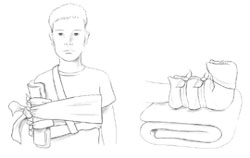See “How to Prevent Muscle Cramps and Strains” for more detailed information on slings, immobilization techniques, and combination bandages/slings to use on different body parts. Like bandages, splints provide support to broken bones, fractures, sprains, and painful joints. When it comes to bones or joints, the most important first aid you can give is stabilization. This keeps those bruised and broken bones immobile so there is no further damage. Splints help the immobilization process. If you don’t have actual boards in your first aid kit, use your imagination. Almost any hard, straight object will do. A rolled up newspaper or magazine, a baseball bat, a pillow, a folded blanket, an umbrella, or even a broom may be used to provide stabilization. Regardless of what you use as a splint, it must be securely attached to keep the body part immobile. And, for secure attachments, don’t go any further than the closet. Belts, ties, sleeves ripped from shirts, twisted-up T-shirts, stockings, and even underwear can be used as slings. They can easily reach around the arm or leg and be knotted, tied, or buckled securely. The table below contains suggestions for using basic everyday items to create splints for various body parts.
